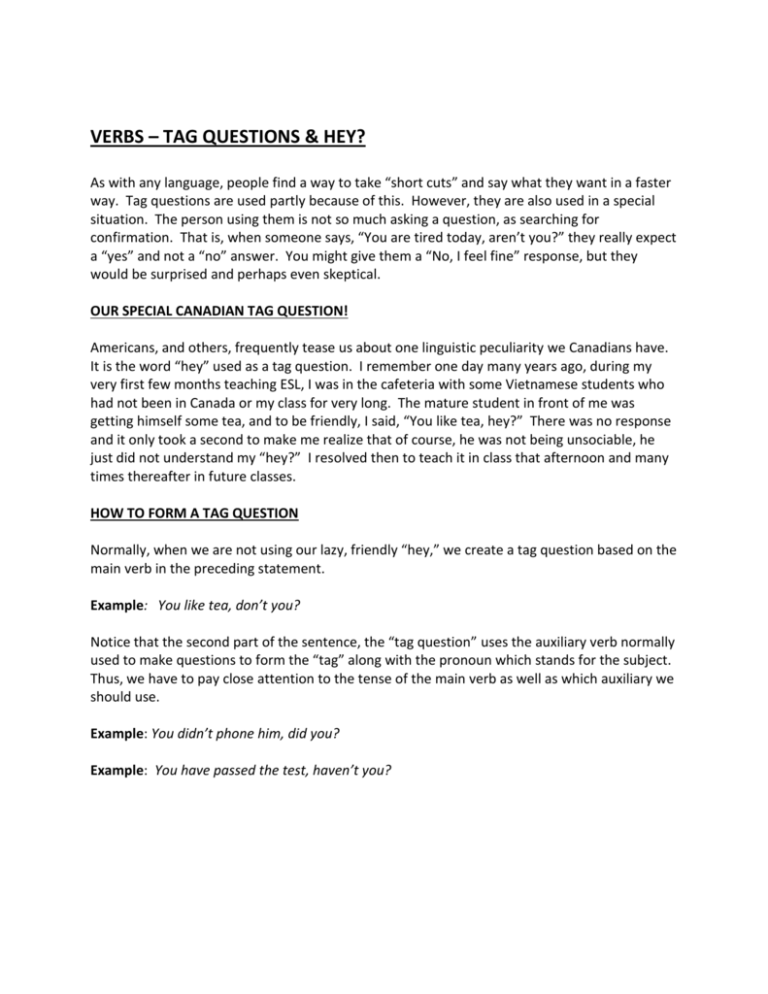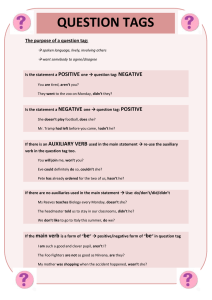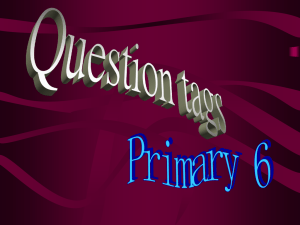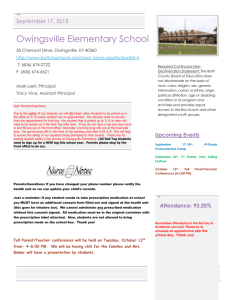Tag Questions & Hey
advertisement

VERBS – TAG QUESTIONS & HEY? As with any language, people find a way to take “short cuts” and say what they want in a faster way. Tag questions are used partly because of this. However, they are also used in a special situation. The person using them is not so much asking a question, as searching for confirmation. That is, when someone says, “You are tired today, aren’t you?” they really expect a “yes” and not a “no” answer. You might give them a “No, I feel fine” response, but they would be surprised and perhaps even skeptical. OUR SPECIAL CANADIAN TAG QUESTION! Americans, and others, frequently tease us about one linguistic peculiarity we Canadians have. It is the word “hey” used as a tag question. I remember one day many years ago, during my very first few months teaching ESL, I was in the cafeteria with some Vietnamese students who had not been in Canada or my class for very long. The mature student in front of me was getting himself some tea, and to be friendly, I said, “You like tea, hey?” There was no response and it only took a second to make me realize that of course, he was not being unsociable, he just did not understand my “hey?” I resolved then to teach it in class that afternoon and many times thereafter in future classes. HOW TO FORM A TAG QUESTION Normally, when we are not using our lazy, friendly “hey,” we create a tag question based on the main verb in the preceding statement. Example: You like tea, don’t you? Notice that the second part of the sentence, the “tag question” uses the auxiliary verb normally used to make questions to form the “tag” along with the pronoun which stands for the subject. Thus, we have to pay close attention to the tense of the main verb as well as which auxiliary we should use. Example: You didn’t phone him, did you? Example: You have passed the test, haven’t you? ANSWERING TAG QUESTIONS At first, most ELL have a bit of difficulty creating “tag questions,” but they have even more difficulty answering them! They easily get confused. To help you respond the way you want to respond, concentrate on the statement part of the question. If you agree with that statement, start your tag with the same construct as the statement. In other words if it is positive, start your answer with “yes”; if it is negative, start your answer with “No.” Example: Your dog is very smart, isn’t he? Yes, he is. Example: You don’t want to get that needle, do you? No, I don’t! Here is an overview of the forms expected answers would take to the various verb structures possible in tag questions: Question Tag Expected Answer Mary is late, Mary isn’t late, isn’t she? is she? Yes, she is. No, she isn’t. John is studying, John isn’t studying, isn’t he? is he? Yes, he is. No, he isn’t. Mr. Johnson works very late, Ms. Johnson doesn’t work very late doesn’t he? does he? Yes, he does. No, he doesn’t. Joanne went to school, Joanne didn’t go to school, didn’t she? did she? Yes, she did. No, she didn’t. He was practicing last night, He wasn’t practicing last night, wasn’t he? was he? Yes, he was. No, he wasn’t. He has written to her, He hasn’t written to her, hasn’t he? has he? Yes, he has. No, he hasn’t He’ll send them tomorrow, He won’t send them tomorrow, won’t he? will he? Yes, he will. No, he won’t. Mary would do it, Mary wouldn’t do it, wouldn’t she? would she? Yes, she would. No, she wouldn’t. They can help him, They can’t help him, can’t they? can they? Yes, they can. No, they can’t. It’s cold out, It was raining, It has snowed since yesterday, It won’t hail, isn’t it? wasn’t it? hasn’t it? will it? Yes, it is. Yes, it was. Yes, it has. No, it won’t. There are a lot of people here, There is a lot of work to do, There aren’t any problems, There isn’t anything to do, aren’t there? isn’t there? are there? is there? Yes, there are. Yes, there is. No, there aren’t No, there isn’t. NOW YOU KNOW WHY WE USE “HEY?”







